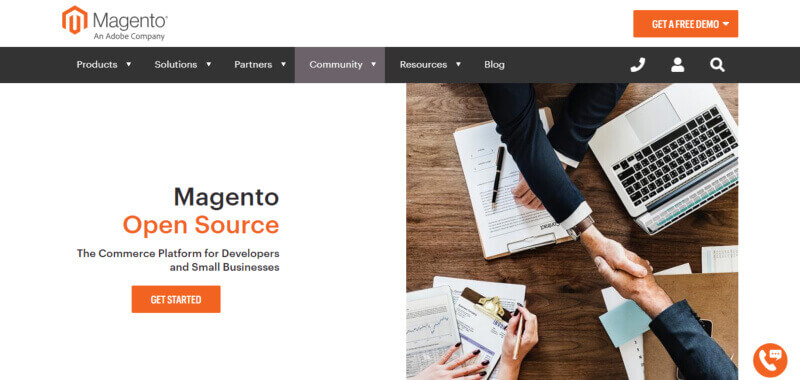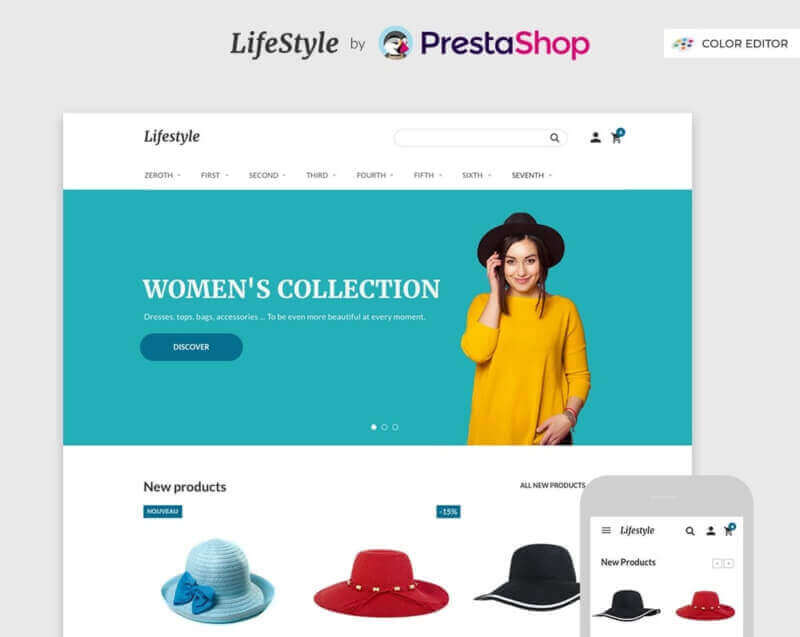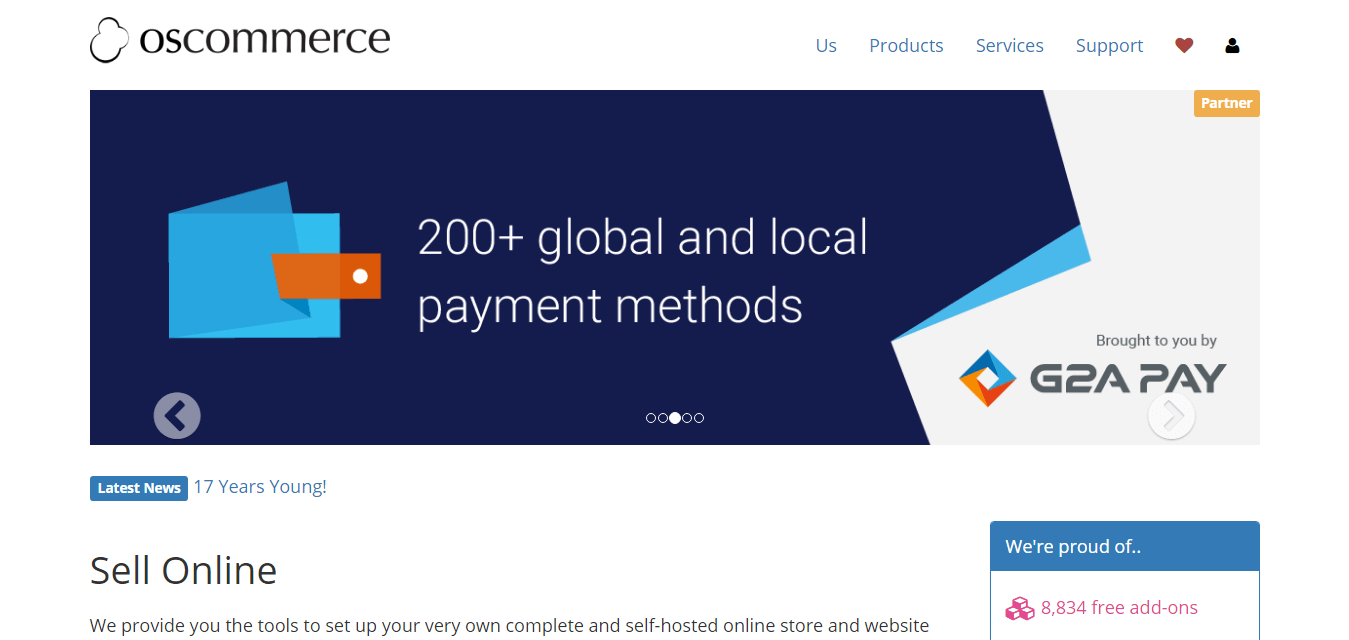If you’re looking for a cheap or free open source ecommerce platform, you’ve come to the right place.
Well, technically, you could choose just about any ecommerce framework, since the majority of them are rather inexpensive as it is.
However, the open source model has brought about all sorts of praise from the people who use it, especially considering these online store systems are completely free, they’re managed and developed by numerous people around the world, and you can typically find lots of documentation and blog posts to guide you along your way.
When researching and choosing any of these ecommerce frameworks, it’s important to decide the type of development experience you’re looking for.
Here are a few questions you should consider asking yourself:
Are you interested in self-hosting?
Or would you rather pay a small fee per month to have hosting and all ecommerce features wrapped up in one nice package?
One of the main decisions is whether you’d like one of the open source (free) ecommerce platforms or a more user-friendly one that involves a monthly fee.
For instance, you could opt to pay as little as $9 per month for an ecommerce platform like Shopify, which has everything like hosting, a website builder, plugins, marketing tools, and inventory options included.
I personally would always go with an option like Shopify over an open source system, but there are some reasons to consider the latter:
- Open source ecommerce frameworks are free.
- You often have more creative control over the design and how the store works.
- Open source solutions are often packed with more unique features because they are constantly being developed.
- You can control things like hosting, plugins and themes that would go into your store.
As always, there are several downsides to open source:
- Open source ecommerce platforms typically require more development or coding knowledge (but you can always hire a developer).
- You have to look around to find a server for hosting by yourself.
- All the site related operations such as maintenance, security, and speed optimization have to be done by you.
- The website designers are usually less user-friendly compared to ones in major ecommerce frameworks like Shopify.
- You don’t get dedicated support. So, if you’re someone who needs to call or email a support rep, open source might not be for you.
It’s entirely up to you to decide which type of platform is right for you, but for now, let’s talk about the best open source ecommerce platforms on the market.
1. WooCommerce (On WordPress)

WooCommerce is a WordPress plugin, so you’ll have to install WordPress (open source) on your host, then install the WooCommerce plugin onto your site. It automatically turns any WordPress website into a fully functional online store, with inventory management, coupons, and product pages.
Benefits:
- The plugin is free to download and install. Many stores don’t need anything more than the plugin.
- It connects to all major payment gateways.
- With a WooCommerce theme, you hardly have to do any work besides adding content.
- You can offer coupons and discounts, along with adding multiple other features with the help of the extension library.
Downsides:
- There are plenty of extra expenses such as a WooCommerce theme, extra extensions, hosting, and domain name.
- WooCommerce has several moving parts. On the surface, it requires hosting + WordPress + the WooCommerce plugin. Beginners can get intimidated by this, especially with tasks like SEO, security, hosting, and caching.
- WooCommerce technically works with all WordPress themes, but it’s kind of a joke unless you get one made just for WooCommerce.
2. X-Cart

X-Cart has helped to create over 35,000 online stores, and this has been growing over the past years. As with all of these ecommerce platforms on the list, it’s free, open source, and self-hosted.
X-Cart is often considered one of the fastest open source platforms on the market, and it also has an incredible number of features for you to sink your teeth into. There’s also a free trial for the premium plan, which goes for $495 (one-time payment).
Benefits:
- It depends on the package you go with, but you can often get full multilingual and multi-currency support.
- It’s free and open source.
- The most advanced developers will have all the control they need with X-Cart. It’s pretty fun to play around with.
- You can integrate your shopping cart with the most reputable payment gateways in the world.
- You can also rest easy knowing that X-Cart is completely secure and PCI Compliant.
Downsides:
- You have no access to direct customer support unless you pay an extra fee.
- You even have to pay for hosting if you opt for one of the paid plans.
- Although the premium plan is only $495 for a lifetime, this still looks somewhat high compared to other options.
- There’s a good chance you’ll have to utilize some sort of manual coding when setting up your store.
3. Zen Cart

The whole reason Zen Cart was created was so that people without development degrees could build their own online stores.
I wouldn’t go so far as to say that you don’t need any coding knowledge, but it’s pretty close.
But, I can assure you this:
Zen Cart is more user-friendly than many of the other open source ecommerce platforms, so it might be worth looking into if you want to scale up quickly but you don’t have advanced skills.
Benefits
- Zen Cart is known as a rather secure software, so you know that your site and customer information is protected.
- Zen Cart is also great for scaling up a store because of its wide range of features and full customization options.
- You can send out HTML emails directly from your website.
Downsides
- The platform doesn’t provide any dedicated support.
- It can sometimes be difficult to upgrade your software.
- There aren’t many add-ons or extensions.
- The templates are far from impressive, but you can still find some made by third parties.
4. Magento Open Source

Magento is one of the most popular open source ecommerce platforms, and for good reason.
To start, it has more features than you can ever expect to use. However, this opens up all sorts of avenues when it comes to marketing to your customers and creating things like membership plans, recurring payments, and discounts.
Do you seek complete control over the design and functionality of the site?
If the answer is a solid yes, consider Magento Open Source. It’s very similar to that of WordPress, where the community is strong, you can choose from hundreds of thousands of themes, and there are plenty of extensions to get your hands on.
Benefits:
- It’s free, and there’s a paid version if you want to upgrade.
- You almost never need to look for an extension with Magento, since the feature list is overwhelming.
- You can send out product alerts to customers for automated marketing.
- The platform lets you make separate multi-lingual sites that load up depending on the user’s location.
- You can customize the user interface however you want.
Downsides:
- Magento is packed with features, but that can also make it clunky and resource-hungry. Therefore, you might have to allocate a decent amount of money and time for optimization.
- Although you can learn how to use Magento, the main reason you would consider it is if you had development skills. Larger companies are known to go with Magento because they have the access and money to get a developer who knows code.
5. OpenCart
Compared to other open source platforms, OpenCart is actually pretty easy to use and lightweight. It’s free and there is a decent community to turn to if you have problems when designing your store.
I recommend it for startups since it doesn’t take too much time to customize the website from scratch.

Due to the ease of use, the overall cost of setting up a store typically decreases.
For instance, you don’t have to pay for a special developer, the themes aren’t expensive, and you definitely don’t need any plugins.
Benefits
- The startup costs are pretty low.
- The features are solid, and the large catalog functionality works wonders for order processing.
- The average person should be fine with setting up OpenCart. Not to mention, it doesn’t suck down resources like Magento.
Downsides
- When you look at the feature list of Magento compared to OpenCart, it’s no comparison. Magento wins by a landslide.
- Performance is not a strong suit with OpenCart, so sometimes you have to get an extra plugin for this.
- Although it’s easier to use for beginnners, this means that the customization options are also fewer. You might consider OpenCart as one of the few open source ecommerce platforms that experienced developers would rather avoid.
6. PrestaShop

PrestaShop is a somewhat new in the ecommerce platform game, but it’s made a name for itself with its ease of use and the beautiful interface. Another thing to consider is that it doesn’t take much experience to install the plugin.
Therefore, beginners and intermediates will find it pretty easy to get started.
Benefits:
- PrestaShop has a user-friendly interface with effortless inventory management and a process for store maintenance that anyone could understand.
- PrestaShop provides a beautiful interface for establishing different websites for multiple languages and currencies.
- This is a fairly lightweight ecommerce platform so you don’t have to worry about it slowing down your site or running slowly when you design the site on your computer.
- It has multi-vendor support if that’s what you’re looking for.
Downsides:
- PrestaShop isn’t as robust as other options like Magento, so the scalability isn’t quite there. You could expand into a large, international store using the software, if necessary. However, it’s really suited for small to mid-sized businesses.
- It’s not required to install any extra modules for a regular online store, but more often than not it seems like you’ll need to pay for some sort of extension. And they aren’t cheap.
- The default theme provided isn’t nearly as nice looking as you would find on other open source software.
- PrestaShop is a little lightweight in terms of marketing tools. For instance, you can’t cross-sell products (at the time of this article).
7. osCommerce

With osCommerce, you have access to a thriving community of developers and users, with a wonderful forum to check out solutions to your problems and talk with other people. Almost 300,000 online stores are made with osCommerce, so you know there are plenty of companies that already find it suitable.
The pricing is obviously a plus since you don’t have to pay a dime to launch an online store. I would also give it top marks for the features, online support, and ease of use.
Benefits:
- The online support is pretty amazing. Obviously, you’re not going to be getting direct support, but the osCommerce forum has millions of active conversations that you can search. You also have the option to share your own thoughts or questions.
- Similar to WordPress, the strong community means that you also have access to many plugins and add-ons. Developers mostly give these out for free, but you’ll also find some that you have to pay for, or somewhere you might need to upgrade in order to get better features.
- One of the great things about osCommerce is that it’s easy to open up and make more advanced customizations to. Even less experienced developers can go in there and make modifications rather easily. In addition, you shouldn’t have any problem finding and paying a developer to work with osCommerce.
Downsides:
- The main reason you might consider going with something different like Magento is due to the reason that osCommerce isn’t known to scale that well. It’s entirely possible to make a larger ecommerce website, but I recommend it purely for small to midsized stores.
- The osCommerce software requires more maintenance than other platforms. This means that you’ll have to spend more time making updates, keeping the site secure, and working on things like SEO.
- Because of your ability to really play around with the code in osCommerce, it can be more prone to errors and breakages. You probably don’t want an ecommerce site to ever break, so it’s important to find an excellent developer who knows how to protect the site.
8. JigoShop

JigoShop often gets compared to WooCommerce because of its ease of use and clean interface. You can also expand the functionality of the site with a wide range of plugins and add-ons, making your website far easier to scale up.
Overall, the development of JigoShop has improved over the years, so you’ll find that JigoShop is pretty easy to pick up, even as a beginner. You’ll find a basic dashboard, incredible themes (which are better than most themes from other platforms,) and a speedy interface when adding anything from products to promotions.
Benefits:
- You can’t find an easier to use open source ecommerce platform than this. Other than WooCommerce, this would also be on my list for beginners or intermediates.
- You can choose from a large selection of themes, many of which are some of the best-looking themes on the market.
- It’s fairly easy to edit the code for your site, and you shouldn’t have any problems finding a developer who’s comfortable with JigoShop.
- The integrations are aplenty, similar to that of WordPress where you can search online for the type of add-ons you want and it returns dozens of solutions.
Downsides:
- You don’t get any options for customer support. You’re left to the forums and blog posts online.
- The initial feature set isn’t all that plentiful so you are expected to install some add-ons. Some of them are free, while others are not.
- Although the themes look wonderful you’ll have a hard time locating themes for free. You can find some free solutions, but these are usually a little watered down. Therefore, if you go with JigoShop you should keep the theme expenses in your mind.
9. Drupal Commerce
Drupal is one of the most common options to go with when designing any kind of website. It’s one of the close competitors of WordPress since a strong percentage of the internet is powered by Drupal.
Not to mention, you can make pretty much any type of website with it.

As for Drupal Commerce, this is a separate module that allows you to build your ecommerce site rapidly, and it’s one of the best solutions if you plan on scaling up quickly.
The bonus is- there’s a huge community of people behind Drupal, so you can turn to the forums, social pages, and blogs for support.
Benefits:
- Drupal was designed with the idea that only professionals were going to use it. This is why if you’re a developer you’ll feel right at home. The initial goal of Drupal has carried over throughout the years and it’s one of the main reasons it’s so powerful.
- It has built-in caching, so the overall speed and performance are much better than other open source ecommerce platforms.
- Unlike many other free open source solutions, Drupal Commerce has its own security system built in. It also gets updated frequently so you should be fine when protecting your site.
- The online community is always there to help you along your way.
Downsides:
- You’re going to have a tough time running an online store if you’re new to Drupal Commerce. It’s hard to learn and most of the discussion in the community is coming from more experienced developers.
- Drupal Commerce websites can become resource hogs since they often turn into large sites with lots of components and modifications.
- Even if you’re an experienced developer, you might find the interface to be complicated.
- There’s no chance of paying for a low price host with Drupal Commerce. You need high power and speed, preferably a VPS or dedicated server.
10. WP eCommerce

WP Ecommerce is the overshadowed cousin of WooCommerce. They’re not technically related at all, but it’s a solid WordPress plugin that doesn’t get nearly as much attention as WooCommerce.
Let me tell you how it works. First, you install WordPress on your hosting server, followed by the WP eCommerce plugin.
This transforms a regular WordPress dashboard into an ecommerce control center. So, you can add products, run promotions, create categories, and more.
As simple as that!
Smaller sites will be fine with the plugin, but you have to install paid add-ons for extra functionality.
Benefits::
- You actually get direct support if you pay for an add-on. Apparently, that support is only good for the add-on you purchased, but you might be able to get information out of a rep that’s not related.
- The plugin supports about a dozen payment gateways, but WP eCommerce provides support if you need to go with a gateway that isn’t in the system.
- The backend is easy to navigate and the frontend results look pretty clean and modern. What’s more is that you can customize all of this easily with some simple CSS and HTML.
- You can pay for direct customer support.
Downsides:
- There aren’t many add-ons.
- The multi-lingual tools are just okay. Apparently, there are more advanced multilingual and multi-currency tools coming in the near future, so I’ll see how that goes.
- You’re not going to find nearly as many WordPress themes for WP eCommerce as you are for WooCommerce.
11. Ubercart

Ubercart is often compared to Drupal Commerce in blog posts.
Drupal Commerce was created by an old Ubercart developer. Therefore, many people argue that Ubercart is the best because it’s the original and has more features to play around with, while others state that Drupal Commerce is the more improved version of Ubercart.
This is what you can normally find when an employee leaves his or her company to create an own and fire up the competition.
But, there are significant differences, making it rather important to find the one that fits your business the best. It would be a pain to migrate from one to the other after making a wrong choice.
In short, both are highly customizable, but Drupal Commerce is more geared towards complex customizations. Most of the differences can be found in the extensions and add-ons, since some extensions just aren’t available in each library.
That’s why it’s essential to research which add-ons are needed for your company before pulling the trigger on an ecommerce platform like this.
Benefits:
- The activity logging in Ubercart is a fancy way to locate order statues no matter where a customer is in the purchasing process.
- Although both Ubercart and Drupal Commerce are developer friendly, I’d argue that Ubercart is better for less experienced users.
- It’s simple enough to work well for smaller stores, but you do have the capabilities to expand.
- Payment modules and shipping options are all packaged into the open source ecommerce platform. Therefore, you don’t have to think much about that when launching.
Downsides:
- The customization controls are less powerful in Ubercart when compared to Drupal Commerce. This can be a good thing for newer developers, but some more advanced users might want more.
- Although you can scale up to support lots of products and product variants, Drupal Commerce is definitely more suitable for a large online store.
- The SKUs are not as cut and dry as the competition, so users may have trouble when working with weight calculations for shipping.
Is An Open Source Ecommerce Platform Right for You?
I just want you to know that there are many other open source software which I haven’t mentioned.
The best part is every single one of these is free and constantly in development. That’s a huge plus if you’d like to save a little money in the short term and scale up easily in the long term.
Even though open source ecommerce platforms have their advantages, you should seriously consider a non-open source solution like Shopify, Bigcommerce, or Volusion. With these platforms you only pay a small monthly fee, you don’t have to maintain your site as much or look for hosting, and always get dedicated customer support.
In my opinion, this type of ecommerce frameworks is for rapidly scaling companies that are going to hire a developer (or a team of developers) to run the entire website. But if you don’t have the money for this type of employee, you’re better off scaling up with something like Shopify.
If you are looking to develop an eCommerce store at a reasonable price then contact the leading eCommerce Development Company, Skenix Infotech to get the free estimation.

